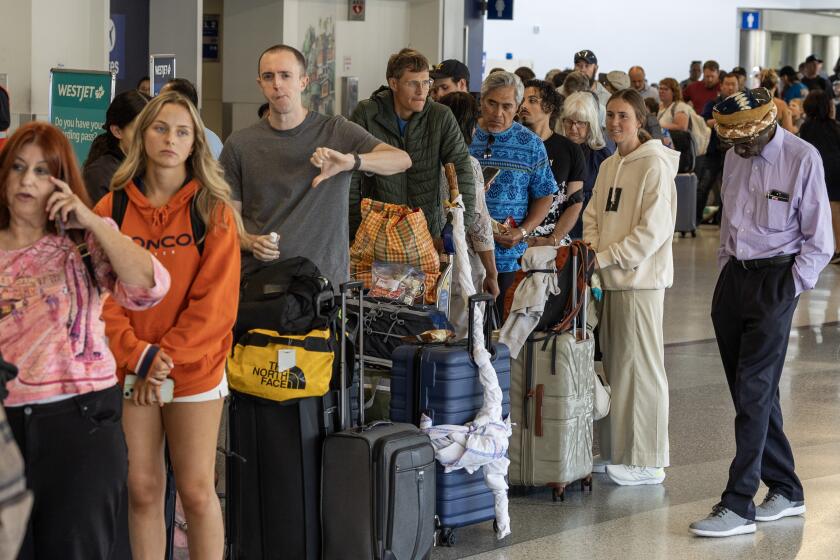Burn Central : Treating Patients is a Team Effort at Valley’s Only Burn Center
Treatment and recovery for a serious burn injury is usually a painful and tedious process. Because they require specialized care, patients with major burns need treatment at a specialized burn center. In the San Fernando Valley, such injuries are treated at the Burn Center at Sherman Oaks Community Hospital. The burn unit there is one of three in Los Angeles County and the only one in the Valley.
The Sherman Oaks Burn Center consists of rooms for emergencies and surgery and therapy areas for pre- and post-operative care. Every year 350 to 400 burn patients are treated at the center, which has a 25-patient capacity and treats patients with minor as well as serious burns.
A burn team consists of surgeons, nurses, technicians and therapists who administer care and monitor progress throughout treatment--from skin graft surgery to post-operative rehabilitation. Return visits are routine for seriously burned patients, who often need numerous graft surgeries. One of the Old Topanga/Calabasas fire’s most seriously-injured victims last year was Ron Mass, who endured more than 30 graft surgeries at the center.
Layers of Protection
The skin consists of two main layers, the epidermis and the dermis.
Degrees of Burn:
* First degree: Affects only epidermis. Skin reddens and may peel, but does not blister.
* Second degree: Affects epidermis and dermis. Skin blisters.
* Third degree: Skin’s entire thickness is destroyed.
Skin Surface Area
This is a rough guide to what each section represents of the total skin area. (graphic)
Patients burned on more than 20% of their body are put in burn intensive care units.
Hyperbaric Chamber
Lying inside the single-person chamber, the patient breathes almost 100% oxygen. Increased oxygen promotes healing.
It takes about 10 minutes for pressure inside the chamber to equalize and the patient stays in the chamber for about an hour. A patient may undergo several chamber treatments a day, depending on the extent of the injuries.
What Helps Healing?
* Nourishment: Badly burned people often require twice as many calories, as their bodies use massive amounts of energy to fight off infection and eliminate toxins.
* Preserving mobility: Patients are given physical therapy to prevent joints from stiffening and blood clots from forming.
Treating the Victim
What happens when a critically burned person reaches the Sherman Oaks Burn Center:
Day 1
* After arriving by ambulance or helicopter, the patient is examined by specialists. A pulmonologist checks if victim can breathe freely or if flames and smoke have damaged throat and lungs so much that a breathing tube must be surgically inserted. Victim is also examined by an infectious disease specialist and, if there are facial injuries, an ophthalmologist.
* Meanwhile, the patient is stabilized. Wounds are covered with a dressing, which reduces pain and helps keep out bacteria, and pain-killing drugs are administered. After discussions with family, victim may also be visited by a staff psychiatrist, who begins counseling in an effort to prevent the patient from suffering later from post-traumatic stress disorder.
Day 2
* The patient is taken to a special room for his first debridement, or removal of dead skin, a major source of infection. A hospital aide uses a sterilized metal scraper to remove dead skin. A gentle stream of water from a hose is also used.
In cases of severe and widespread burns where debridement is too painful, the procedure is done surgically under anesthetic. Surgeons use either scrub brushes or a dermabrader, a sander-like device, to remove dead skin.
* Surgeons may then apply a “biological dressing” of cadaver skin, called a homograft. This covering helps reduce pain and promotes a healthier base for later grafts of the patient’s own skin.
Day 3 or 4
* The patient undergoes surgery to attach grafts of his own skin, called autografts. If most of the “donor sites” on his body (such as legs, arms or back) have been burned, small sections of skin can be cloned in the laboratory. Skin is removed from the patient with a surgical tool known as a dermatone. To stretch it further, the graft is run through a device called a mesh graft, which perforates the skin with numerous tiny cuts, which will allow fluids to flow through skin.
Day 10 or 11
* Surgeons check to see if the graft has taken, or the body has rejected it.
Sources: The Burn Center at Sherman Oaks Hospital and Health Center; American Medical Assn. Encyclopedia of Medicine; Researched by JACK CHEEVERS and JULIE SHEER / Los Angeles Times
More to Read
Sign up for Essential California
The most important California stories and recommendations in your inbox every morning.
You may occasionally receive promotional content from the Los Angeles Times.






